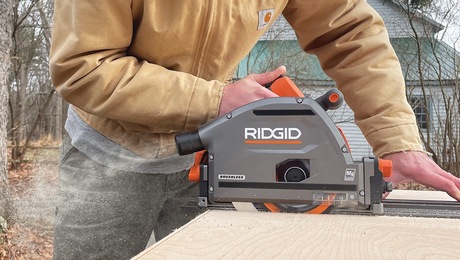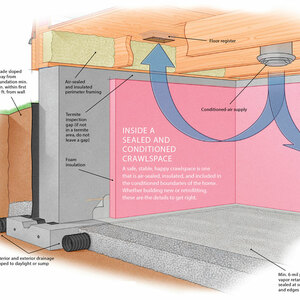We’re building a 8×12 shed with a simple gable roof using 2×6 rafters. This is our first time building a house so things haven’t been very smooth, but at least we managed to conqure them, but putting up the rafters proved to be a real difficulty.
Following what Larry did in his video, we end nailed one of the rafters, and then tried nailing through the ridge into the other. Problem is, after doing so, there’s a gap between the rafter that had been nailed from an angle and the beam. Hammering the nails doesn’t help, I’ve tried fixing a block to both sides of the rafters and installing a clamp in an attempt to pull them together but it didn’t work. It seems to me that the angled nail just couldn’t close the gap between the rafter and the ridge.
So far I came up with the following solutions:
1. Get a nail gun. This would drive a nail instaneously and secure the rafter to the ridge with no gap.
2. Find a way to secure the rafter temporarily. I don’t want to use hangers since the ceiling would be exposed, so I’m considering using screws or some other means of butting the rafter tight to the ridge ( I take it that on large scales the rafter is much heavier and less prone to vibration created gaps).
3. Toe nail the rafter to the ridge instead. I see this being done by production framers. Though would the solve the problem of gaping rigde and rafter.
Another quesion is that we’re using a 2×6 for the ridge board. We’ve centering it so that there’s a 7/16″ gap on the top and bottom. Is this a good practice? Since 2×8 seems a bit overkill and hard to get up there.
Any advice is appreciated.


















Replies
As for the ridge board. The board carries no load, in fact a 1 x 8 would be fine as it only serves to hold the rafters in place and to space them on your 16 or 24 inch centers. It would be best to have the ridge board the full depth of the rafter cut, but for an 8 x 12 shed ......
As for nailing. You should be able to face nail through the one side and then toenail the rafter on the otherside throught he rafter and into the ridge board. your problem is your technique I would guess. Cant say much about that.
Thanks for the reply, I guess I'll stick to my current 2x6 ridge board since as you said, it's not load bearing.
About my technique, I didn't toe nail the bird mouth to the top plate first before nailing the rafter to the ridge, perhaps nailing it down at the bottom would press the rafter tight against the ridge, solving the gaping problem.
Another question, since my gable overhang is small (1'), I didn't use the lookout and gable plate style, instead I'm using the simpler extended ridge beam method. Should I go with a single barge rafter attached to the stud rafter using ladders or should I build a ladder on the ground and carry it up, forming a double rafter at the wall as done here.
It seems to me that the extra rafter is redundent, besides adding more weight to the overhang it doesn't strengthen the roof structure really. Though I can see the benefit is that you can build the ladder on the ground as opposed to building it on roof.
small structure
Are you going to have a 2 by sub-facia? If so I would just nail your gable rafter toteh ridge and to the subfacia. YOu probably dont even need a ladder/block in there, although those blocks might help with potential sagging in the future, but then again the ridge board and sub facia are stout and the rafter span small.
Good tip, that's what I thought too. I'm thinking of using cedar for the sub facia, a local cedar mill nearby carries 1-1/4" cedar boards which I take to be sufficient. I'll probbaly add blocking for stability, I suppose both screws and nails would work here.
What i meant by subfascia..
What I meant by subfascia is a peice of 2 by construction lumber, a structural material which when extentended past teh gable end wll struturally support the barge (fly rafter). Then you nail your decorative fascia to the sub fascia, ususally use 3/4 stock.
Now a 1 1/4 cedar board for a shed your size is probably fine, but unless you want your fascia to look beefy as looked at from below, might be alot more expensive than a regular 2 x 6 subfascia to which a 1 by cedar fascia is nailed.
All of this discussion is fun but probably unnecessary. Your shed is small. It probably will not fall down regardless of which plan you use and you probably wont spend or waste too much money any which why you do it.
User
with the rafter cut properly, there should be no gap when nailing it off both at the plate and to the ridge. Are you sure of the cuts?
There's a gap at the bird mouth equal to the gap at the ridge, meaning the rafter isn't in place. I'm thinking of securing the birdmouth first with toe nails prior to nailing at the ridge to prevent it from gaping during nailing.
yeah...
If your cuts are right it must be technique. It is hard for one person to install rafters, even little baby ones. t can be done though.
You really needed a next size larger ridge board so the heal of the plumb cut on the rafter there is fully seated on teh ridge board. AS the mositure content of the board changes the heal will stay in place while the tip grows in and out. The 'perfect' mitered joint at the rafter to ridge will never last after a MC change. best to cut rafter so teh heal sits on something firm and not worry about perfection but close enough to toe nail the remainder of the rafter.
With the heal of that rafter angle firmly planted on the ridge it'll always carry all of the load it's capable of.
Rafter
done a bunch of rafters solo. Technique is as follows. Screw a stop on bottom of rafter so the birds mouth is close finish position. This stops the rafter from sliding off top plate. Then put in place at ridge. Use deck screw to pull the rafter tight to beam then nail off per best practice.
all the work is done from the ridge and after prep and stacking entire roof can be done from top position.